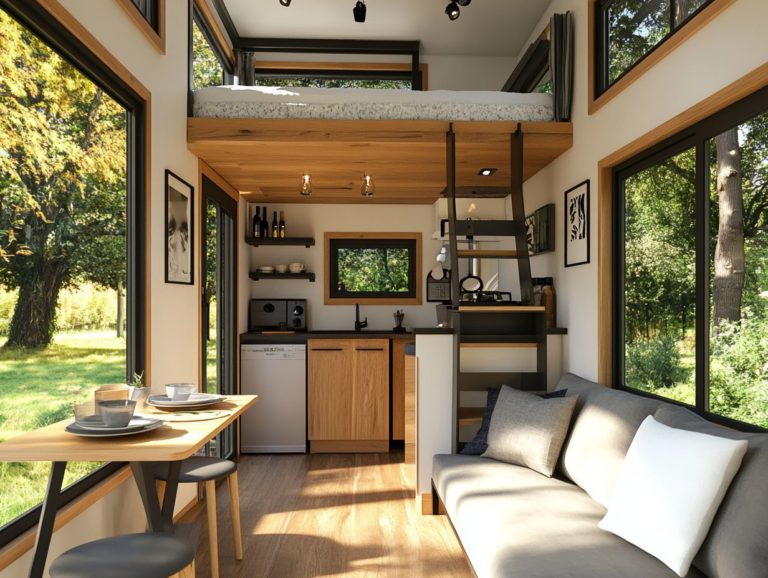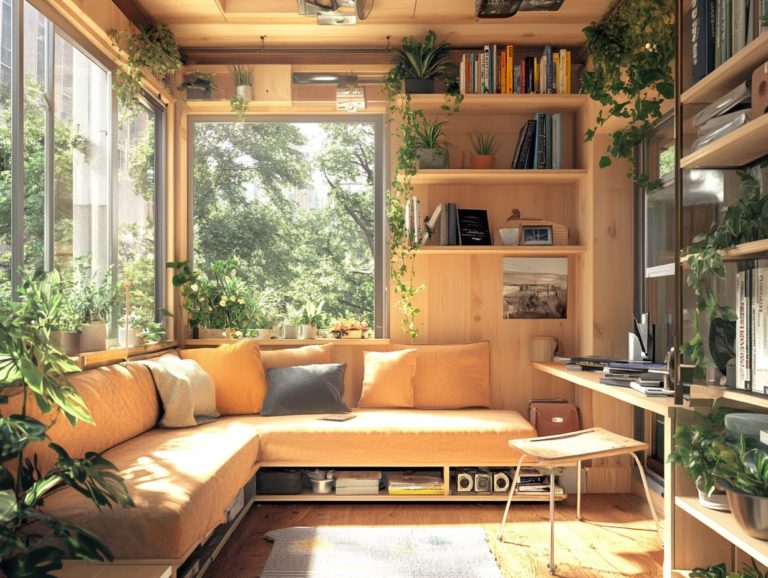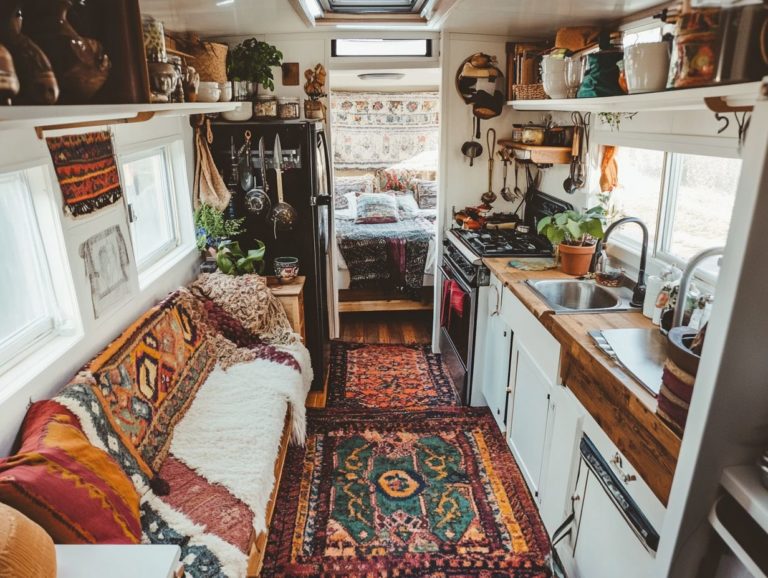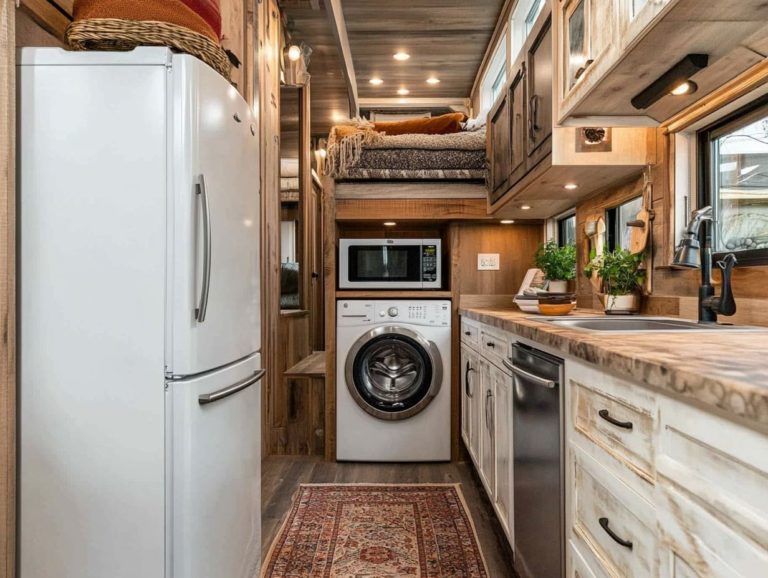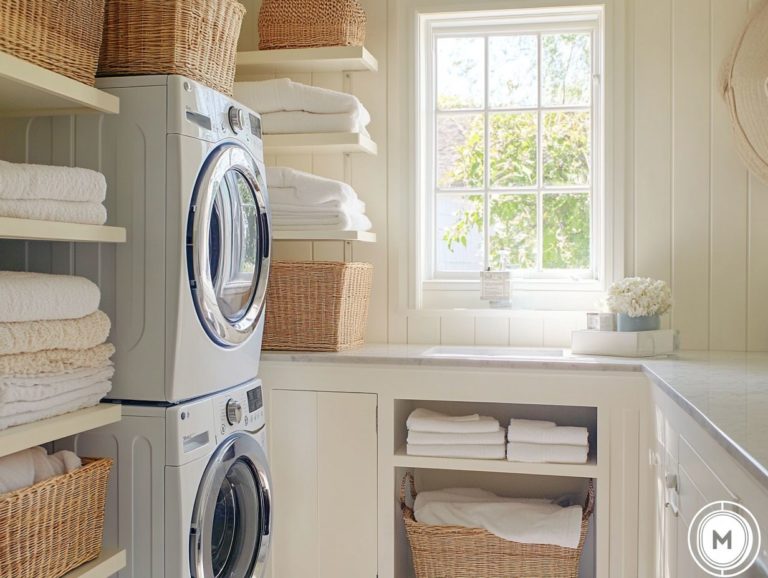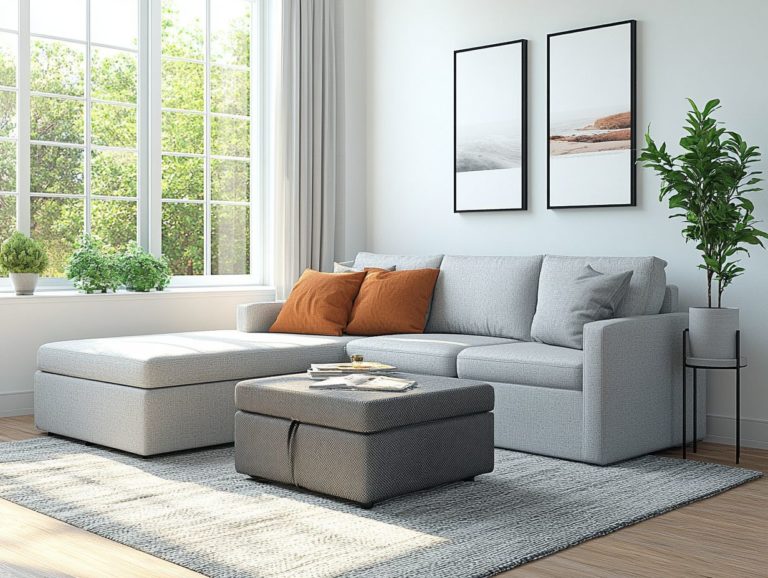7 Effective Decluttering Tips for Tiny Homes
Living in a tiny home can be a cozy and fulfilling experience, yet it often presents the challenge of limited space.
If you’ve ever felt the weight of clutter closing in, you’re certainly not alone. This article presents seven effective decluttering tips tailored for tiny homes. From crafting a solid plan to implementing clever storage solutions, these strategies will empower you to create a more organized and harmonious living space.
We ll also explore how decluttering can enhance your mental well-being and offer practical advice for sustaining a clutter-free environment.
Ready to transform your tiny space? Let s dive in!
Contents [hide]
- Key Takeaways:
- 1. Start with a Plan
- 2. Declutter One Room at a Time
- 3. Use the ‘One In, One Out’ Rule
- 4. Utilize Vertical Space
- 5. Invest in Multi-Functional Furniture
- 6. Get Rid of Items You Haven’t Used in a Year
- 7. Utilize Storage Solutions
- How Can Decluttering Greatly Help Your Mental Health?
- Key Takeaways:
- 1. Create Your Decluttering Game Plan!
- 2. Declutter One Room at a Time
- 3. Use the ‘One In, One Out’ Rule
- 4. Utilize Vertical Space
- 5. Invest in Multi-Functional Furniture
- 6. Get Rid of Items You Haven’t Used in a Year
- 7. Utilize Storage Solutions
- How Can Decluttering Improve Your Mental Health?
- Frequently Asked Questions
Key Takeaways:
- Plan Ahead: Start with a clear plan to declutter efficiently.
- One Room at a Time: Focus on decluttering one room at a time.
- One In, One Out: Keep things tidy by removing one old item for every new item you bring in.
- Maximize Vertical Space: Use wall space to create more storage options.
- Invest in Multifunctional Furniture: Use furniture that serves multiple purposes.
- Purge Regularly: Get rid of items you haven’t used in a year.
- Use Smart Storage Solutions: Organize with baskets and shelves.
1. Start with a Plan
Starting with a strategic plan is essential if you’re looking to effectively declutter your living space. In tiny homes, maximizing space is key to family bonding and maintaining a tidy environment.
Having a clear roadmap helps you set specific goals. This makes the decluttering process feel more manageable. Set achievable objectives, like tackling one room at a time or committing to purging often a set number of items each week. This will keep you motivated and allow you to see your progress firsthand.
Creating an inventory of items you no longer need can streamline decision-making. It helps you determine what truly deserves a place in your home. Establish designated room zones within each room to enhance organization and cleanliness, ensuring everything has its spot.
2. Declutter One Room at a Time
To achieve an organized home, tackle the decluttering process one room at a time. This is especially important in small spaces where each area plays a critical role in maintaining cleanliness and comfort.
By focusing on a single area, you can assess the value and function of each item in your daily life. Dedicate time specifically for this task and ensure your environment is free from distractions.
Begin with the most cluttered space and create three categories: keep, donate, and discard. This approach simplifies your decision-making, helping you clarify what enhances your living experience.
Incorporating daily decluttering habits like setting aside just ten minutes for a quick tidy-up can significantly reduce clutter over time. This will cultivate a more manageable and serene atmosphere in your home.
3. Use the ‘One In, One Out’ Rule
Implementing the ‘One In, One Out’ rule is a smart strategy for decluttering your space. For every new item you bring into your home, remove an old one to keep your living area tidy.
This method not only maintains cleanliness but also reduces clutter, paving the way for a more organized environment. For example, if a shiny new gadget like a Magic Bullet comes into your kitchen, consider donating or discarding an older tool that you no longer use. When a fresh piece of clothing enters your closet, assess an item that doesn t fit or shows wear.
This ongoing process encourages regular checks of your inventory items, ensuring your personal spaces stay functional. By consistently applying this rule throughout various rooms, like the living area and bathroom, you ll create a serene atmosphere free from unnecessary distractions.
Start your decluttering journey today!
4. Utilize Vertical Space
Utilizing vertical space is a crucial technique for maximizing small houses and tiny homes. It provides creative storage solutions that keep your living environment organized and functional.
This approach enables you to take advantage of underused spaces, transforming your walls into storage opportunities. For example, adding floating shelves not only showcases your favorite decorative items but also provides a practical spot for books or plants without encroaching on your valuable floor space.
Strategically placed wall hooks can be your secret weapon for hanging coats, bags, or kitchen utensils, ensuring easy access while maintaining an appealing aesthetic. Cabinets that extend to the ceiling are perfect for storing infrequently used items, decluttering lower surfaces and enhancing the overall design of the room.
By incorporating these vertical solutions, you can create a sense of openness, making your small living areas feel more spacious and inviting.
5. Invest in Multi-Functional Furniture
Investing in furniture that serves multiple purposes is a savvy decision for anyone residing in small homes. Not only does it maximize your space, but it also offers organized storage solutions and versatility in your living area.
By incorporating items like sofas with hidden compartments, extendable tables for entertaining guests, and ottomans that double as both seating and storage, you can effortlessly maintain a clutter-free environment. These innovative designs elevate the aesthetics of your room and help you live more simply by promoting intentional living.
Imagine a sofa with storage that neatly tucks away blankets or magazines, while an extendable table adapts seamlessly from intimate dinners to lively gatherings. Furniture that serves multiple purposes transforms limited square footage into a well-organized sanctuary, enhancing your daily life and making it all the more enjoyable.
6. Get Rid of Items You Haven’t Used in a Year
A practical guideline for decluttering is to part ways with items you haven t used in a year. This easy trick can quickly turn your messy space into a tidy haven!
By following this straightforward rule, you alleviate physical clutter and clear your mind, allowing you to focus on what truly matters in your life. Regularly evaluating your possessions fosters a sense of freedom, significantly enhancing your overall well-being.
To effectively determine what deserves a place in your home, reflect on the last time you interacted with each item. Consider whether it holds functional value or sparks joy; if it doesn t, it might be time to let it go.
Adopting a systematic approach, you can create three categories: keep, donate, or toss. This method makes the process less overwhelming and far more rewarding.
7. Utilize Storage Solutions
Utilizing smart storage options is essential for achieving an organized and clutter-free home, enabling you to maximize space while streamlining your cleaning supplies and other items with ease.
By incorporating a variety of storage options think storage containers for categorizing items, baskets for quick access, and thoughtfully designed shelving systems you enhance the aesthetics of your space while cultivating efficient daily cleaning habits.
These solutions significantly reduce the chances of clutter building up, making it much easier for you to maintain order and quickly locate frequently used items. Ultimately, you can create a serene environment that fosters a sense of calm and satisfaction, transforming everyday tasks into more manageable and enjoyable experiences.
How Can Decluttering Greatly Help Your Mental Health?
Decluttering can have a significant impact on your mental health. An organized and tidy home alleviates stress and fosters a sense of control and peace in your environment.
Research indicates that an untidy space may lead to feelings of anxiety and overwhelm. This makes it challenging to concentrate on tasks. In contrast, a decluttered space minimizes distractions, enabling you to focus better and enhancing both productivity and relaxation.
Experts in psychology emphasize that living in a clutter-free environment can significantly enhance your overall wellbeing. It allows for clearer thinking and more effective decision-making. Engaging in the act of decluttering can be therapeutic. It helps you break free from emotional attachments to objects and creates a sanctuary that nurtures mental clarity and tranquility.
What Are the Benefits of Living in a Clutter-Free Space?
Living in a clutter-free space brings a wealth of benefits. You ll enjoy heightened organization, improved mental health, and the joy of bonding with family in a shared, clean environment.
A tiny home can be cozy and fulfilling, yet it often presents the challenge of limited space. If you’ve ever felt the weight of clutter closing in, you’re not alone.
This article presents seven effective decluttering tips tailored for tiny homes. From crafting a solid plan to implementing clever storage solutions, these strategies will empower you to create a more organized and harmonious living space.
We will explore how decluttering boosts your mental well-being and offer practical advice for sustaining a clutter-free environment.
Get ready to transform your tiny space into a peaceful haven! Let s dive in!
Key Takeaways:
- Start with a plan to declutter your tiny home efficiently.
- Declutter one room at a time to avoid feeling overwhelmed.
- Follow the “One In, One Out” rule to maintain a clutter-free space.
- Maximize vertical space and invest in multi-functional furniture for more storage options.
- Get rid of items you haven’t used in a year to free up space.
- Utilize storage solutions, such as baskets and shelves, to keep your tiny home organized.
1. Create Your Decluttering Game Plan!
Starting with a strategic plan is essential if you’re looking to effectively declutter your living space, particularly in small houses or tiny homes where maximizing space plays a pivotal role in family bonding and maintaining a tidy environment.
Having a clear roadmap enables you to outline specific goals, making the decluttering process feel manageable. By setting achievable objectives like tackling one room at a time or committing to purging a certain number of items each week you can maintain motivation and witness your progress firsthand.
Creating an inventory of items you no longer need can significantly streamline your decision-making process. It helps you pinpoint what truly deserves a place in your home. Establishing designated zones within each room enhances your overall organization and promotes cleanliness, ensuring that everything has its rightful spot.
2. Declutter One Room at a Time
To achieve an organized home, you must tackle the decluttering process one room at a time. This is especially important in a small space where each zone plays a critical role in maintaining both cleanliness and comfort.
By concentrating on a single area, you can systematically assess the value and function of each item in your daily life. Start by dedicating specific time for this task and ensuring your environment is free from distractions.
Begin with the most cluttered space and create three categories: keep, donate, and discard. This approach streamlines your decision-making, helping you clarify what truly enhances your living experience.
Incorporating daily decluttering habits like setting aside just ten minutes for a quick tidy-up can significantly reduce overwhelming clutter over time. This cultivates a more manageable and serene atmosphere in your home.
In conclusion, decluttering not only improves your living space but also enhances your mental well-being. Take the first step today and start your journey toward a clutter-free life!
3. Use the ‘One In, One Out’ Rule
Implementing the ‘One In, One Out’ rule is a smart strategy for decluttering your space. For every new item you bring into your home, remove an old one. This ensures your living area remains tidy and manageable.
This approach keeps your space clean and dramatically reduces clutter. It paves the way for a more organized environment. For example, if a shiny new gadget finds its way onto your kitchen counter, consider donating or discarding an older tool that you no longer use. In your bedroom, when a fresh piece of clothing enters your closet, assess an item that doesn t fit or is showing signs of wear.
This ongoing process encourages you to regularly check your inventory. By consistently applying this rule throughout various rooms, like the living area and bathroom, you ll create a serene atmosphere, free from unnecessary distractions.
4. Utilize Vertical Space
Using vertical space is essential for maximizing the potential of small houses and tiny homes. It offers creative storage solutions that keep your living environment organized and functional.
This approach allows you to take advantage of often-overlooked areas. You can transform your walls into dynamically storage opportunities. For example, adding floating shelves shelves that appear to be attached to the wall without visible brackets not only showcases your favorite decorative items but also provides a practical spot for books or plants without taking up valuable floor space.
Strategically placed wall hooks can be your secret weapon for hanging coats, bags, or kitchen utensils. This ensures easy access while maintaining an appealing aesthetic. Cabinets that extend to the ceiling are perfect for storing those infrequently used items, decluttering lower surfaces and enhancing the overall design of the room.
By incorporating these vertical solutions, you can create a sense of openness. This makes your small living areas feel more spacious and inviting.
5. Invest in Multi-Functional Furniture
Investing in multifunctional furniture is a smart decision for anyone living in small homes. It maximizes your space while offering organized storage solutions and versatility.
Incorporate items like sofas with hidden compartments, extendable tables for entertaining guests, and ottomans that double as both seating and storage. This helps you effortlessly maintain a clutter-free environment. These innovative designs elevate your room’s aesthetic and support a minimalist lifestyle by promoting intentional living.
Imagine a sofa with storage that neatly tucks away blankets or magazines. An extendable table can adapt seamlessly from intimate dinners to lively gatherings. Multifunctional furniture transforms limited square footage into a well-organized sanctuary, enhancing your daily life and making it more enjoyable.
6. Get Rid of Items You Haven’t Used in a Year
A practical guideline for decluttering is to part ways with items you haven t used in a year. This simple strategy promotes a tidy home and helps you maintain cleanliness and organization with ease.
By following this straightforward rule, you alleviate physical clutter and cultivate mental clarity. This allows you to focus on what truly matters in your life. Regularly evaluating your possessions fosters a sense of freedom and accomplishment, significantly enhancing your overall well-being.
To effectively determine what deserves a place in your home, reflect on the last time you interacted with each item. Consider whether it holds functional value or sparks joy; if it doesn t, it might be time to let it go.
By adopting a systematic approach, create three categories: keep, donate, or toss. This method simplifies decluttering and makes it a rewarding experience!
7. Utilize Storage Solutions
Using effective storage solutions is essential for achieving an organized and clutter-free home. This enables you to maximize space while streamlining your cleaning supplies and other items with ease.
Incorporate a variety of storage options:
- Bins for categorizing items
- Baskets for quick access
- Thoughtfully designed shelving systems
These not only enhance the aesthetics of your space but also cultivate efficient daily cleaning routines. These solutions significantly reduce the chances of clutter building up, making it easier to maintain order and quickly locate frequently used items.
Create a serene environment that fosters a sense of calm and satisfaction, transforming everyday tasks into manageable and enjoyable experiences.
How Can Decluttering Improve Your Mental Health?
Decluttering can profoundly impact your mental health. An organized, tidy home alleviates stress, promotes minimalism, and fosters a sense of control and peace in your environment.
Research indicates that an untidy space may lead to feelings of anxiety and overwhelm. This makes it challenging to concentrate on tasks. In contrast, a decluttered space minimizes distractions and enables better focus, enhancing both productivity and relaxation.
Experts in psychology emphasize that living in a clutter-free environment can significantly enhance your overall well-being. It allows for clearer thinking and more effective decision-making. Engaging in decluttering can be therapeutic, helping you break free from emotional attachments to objects and create a sanctuary that nurtures mental clarity and tranquility.
What Are the Benefits of Living in a Clutter-Free Space?
Imagine the joy of a well-organized space! Living in a clutter-free space brings a wealth of benefits. You’ll enjoy heightened organization, improved mental health, and the joy of bonding with family in a shared, clean environment.
An orderly home can elevate your daily experience. By minimizing distractions, it becomes easier to focus on tasks, boosting your overall efficiency. When everything has its designated spot, locating what you need becomes effortless, saving you frustration and wasted time.
A serene environment can enhance your emotional well-being, helping reduce anxiety and instill a greater sense of control over your surroundings.
When everyone in the family pitches in to maintain cleanliness, it fosters teamwork and shared responsibility. This strengthens connections and nurtures a supportive atmosphere at home, making it a place where everyone thrives.
What Are the Common Mistakes People Make When Decluttering?
Many individuals encounter common pitfalls when decluttering that can obstruct their progress. You might feel overwhelmed, struggle to maintain cleanliness, or lack a clear organizational strategy.
These missteps can turn what should be a liberating process into a daunting chore. For example, don’t try to clean the whole house at once or set unrealistic goals, as the clutter can quickly become overwhelming.
Concentrate on one space at a time and establish achievable objectives for each session. By maintaining a consistent cleaning routine, you can prevent clutter from creeping back in.
Craft a thoughtful organizational plan; using boxes or labels can help categorize items meaningfully. By applying these strategies, you can transform decluttering from a stressful task into a truly rewarding experience.
How Can You Maintain a Decluttered Home?
Maintaining a decluttered home is all about consistency and effective cleaning habits. By incorporating daily decluttering practices, you can keep your living environment organized and enjoyable.
Setting a routine is essential. Just a few minutes each day can work wonders. Consider dedicating a specific time, perhaps before a meal or right after waking up, to tackle those small clutter piles that tend to accumulate.
Implement practical methods like the ‘one in, one out’ rule to prevent unnecessary buildup. Breaking tasks into manageable chunks ensures that cleaning never feels overwhelming.
By being mindful and incorporating these strategies into your daily life, you can establish a sustainable rhythm that promotes tidiness and brings a sense of calm and clarity to your everyday living.
Start your decluttering journey today!
What Are Some Creative Ways to Store Items in a Tiny Home?
In a tiny home, embracing creative storage solutions is essential for maximizing your space while keeping your living area organized and functional.
Consider tapping into under-bed storage options. Think about rolling bins that glide effortlessly beneath your mattress, granting you easy access to seasonal clothing or extra linens without fuss.
Wall-mounted shelves offer an excellent opportunity to display decor while also providing additional storage space for books and everyday essentials. This allows you to keep your precious floor area clear.
Furniture that doubles as storage, like ottomans with hidden compartments or coffee tables featuring built-in shelving, can significantly enhance the usefulness of your limited square footage. This approach proves that even the coziest of homes can radiate both style and practicality.
How Can You Get Rid of Items Responsibly?
Getting rid of items responsibly is essential for your decluttering journey. It enables you to periodically purge while positively impacting your community through charitable avenues like Goodwill or garage sales.
Donating gently used items minimizes waste in landfills and provides opportunities for those in need to benefit from quality goods. Hosting a garage sale can be an enjoyable way to connect with neighbors while ensuring valuable items find new homes and you earn some extra cash.
Recycling is a responsible approach that helps reduce waste and your carbon footprint, which means lowering the amount of greenhouse gases you produce to protect the environment. These decluttering strategies can bring you great satisfaction, knowing your efforts enrich both the community and the environment.
Frequently Asked Questions
What are 7 effective decluttering tips for tiny homes?
- Utilize vertical space: Make use of wall shelves, hanging organizers, and over-the-door storage to maximize space.
- Embrace minimalism: Consider each item’s value and purpose before keeping it.
- Use multi-functional furniture: Look for pieces that serve multiple purposes, like a storage ottoman or a bed with built-in drawers.
- Create designated storage areas: Designate specific areas for different categories, such as a shoe rack by the door or a basket for mail.
- Implement a “one in, one out” rule: For every new item that enters your tiny home, remove something else to maintain a clutter-free space.
- Take advantage of hidden storage: Use the space under your bed, behind doors, and in other hidden areas for additional storage.
- Regularly declutter and organize: Set aside time each week to declutter and organize your space to prevent clutter from building up.
Act now to make your space shine! Share your decluttering experiences or tips on social media to engage with our community.

